Design and Development of Intelligent Wearable Biofeedback Fuzzy Logic-based Device for Monitoring and Treatment of Voice Loudness
- DOI
- 10.2991/jrnal.k.200221.004How to use a DOI?
- Keywords
- Biofeedback device; fuzzy logic; voice loudness
- Abstract
Development of medical devices are expanding rapidly. This is occurring as results of development of high tech electronics, information technology and wireless communication technology. Integrating these technologies helps to provide good, less cost and more effective healthcare services. In this paper a novel intelligent medical biofeedback device is developed for accurate monitoring of the voice loudness using fuzzy logic compared with proportional control. This accurate biofeedback monitoring device then enhanced treatment of people who are unable to control excessive or low loudness due to intellectual disability or aggressive behavior causing loudness levels rejected by others. These people with this behavior may often be unaware of their problems and hence an intelligent biofeedback device is necessary to be used by the patients outside the clinic for self-controlling excessive or low loudness without the need to follow-up in speech pathology clinic for the continuous therapeutic. The use of the intelligent wearable biofeedback device proved to be an effective due to its enhanced features. The design considerations, enhanced features, simulation and evaluation of the device will be presented.
- Copyright
- © 2020 The Authors. Published by Atlantis Press SARL.
- Open Access
- This is an open access article distributed under the CC BY-NC 4.0 license (http://creativecommons.org/licenses/by-nc/4.0/).
1. INTRODUCTION
There are many voice disorders such as vocal cord nodules, vocal loading and many other speech disorders [1]. These disorders are caused by excessive loudness or speaking loudly due to aggressive behavior or intellectual disability [2]. This vocal abuse may result in vocal cord pathologies such as vocal nodules. This pathology occurs in high percentage of children with voice disorders [3]. On the other side inadequate volume, weak or soft voice due to reduced vocal intensity are classified as voice disorders such as in Parkinsonian patients who are unable to regulate the volume of their speech [4].
Usually the patients with the above behaviors may often be unaware of their problems. So intervention is required to limit these negative outcomes. This intervention using simple verbal prompting by therapist can help patients if instructed to regulate the speaking volume by controlling their loudness but unfortunately such improvement generally is not long-term one. So, voice monitoring is necessary in addition to the use of biofeedback training. The use of biofeedback control instead is more effective compared with the simple verbal control. Feedback using microcomputer-based system and some hardware 1 kg weight was used for speech therapy with Parkinson’s disease patients as in Sicker et al. [5]. Schliesser [6] used the biofeedback training employing electromyography to voice disorders. Another limited functions system using biofeedback analog device is developed by McGillivray et al. [7] to reduce loudness for treating a child with soft nodules on her vocal cords via interrupting child conversation by the therapist with a loud tone when her speech exceeded threshold intensity level. A portable auditory-feedback and vibratory-feedback devices for reducing excessive loudness in a deaf woman with mental retardation were used by Lancioni and Markus [8].
To limit these negative outcomes and enhance the features of the feedback device, a novel intelligent biofeedback device is developed for accurate monitoring and feedback of the voice loudness using fuzzy logic compared to proportional control [9]. This accurate monitoring and feedback with variable alarm device will enhance treatment of people who are unable to control excessive or low loudness accurately. This device is portable and can be used at home without the need to the continuous therapeutic follow-up in speech pathology clinic.
2. MATERIALS AND METHODS
2.1. Device Design Hardware
The intelligent Wearable Biofeedback Fuzzy Logic-based Device for Monitoring and Treatment of Voice Loudness in this work consists of many components including: throat microphone, signal conditioning including amplifiers, filters, rectifier, unity gain buffer, in Programmable System on Chip (PSoC) microcontroller; auditory alarm feedback. The device is battery operated as shown in Figure 1.

Block diagram of the intelligent wearable biofeedback fuzzy logic-based device for monitoring and treatment of voice loudness.
The signal conditioning as shown in Figure 2. It consists of preamplifier, band pass filter to eliminate unwanted noise, main amplifier with an adjustable gain to make the signal bigger, rectifier to turn negative signal values to positive and integrator to evaluate voice intensity over a set time period. A 500 Hz corner frequency low pass filter is considered because this frequency is low enough to include the volume or intensity of the voice. It cuts off the high frequencies associated with pitch, quality, or uniqueness of a particular speech. The gain of the amplifier is 100 since the typical values expected are in the order of 10 mV [10].

Block diagram of the signal conditioning of voice signal.
The voice signal is firstly conditioned using analog circuitary in the PSoC microcontroller and then it passes through 8-bit A/D converter to be digitized for intelligent processing using Fuzzy Logic System (FLS). The feedback is consisting of an audio alarm with duty cycle determined by FLS depends on the low or high loudness levels. The purpose of the feedback device is to warn the patient when his or her speech intensity had gone below or above the specified threshold as input to the FLS based on therapist suggestion. With auditory feedback, the patient would be notified that vocal changes either decreasing or increasing voice level as regulation of voice is needed to be made. Finally, the fuzzy logic in PSoC microcontroller is programmed to process the voice data acquired and to determine when feedback to the patient is necessary as will be discussed in the following section.
2.2. Design of Loudness Fuzzy Logic-based System
Fuzzy logic-based system using graphical programming method, can be designed with qualitative description for the system and avoiding the tedious method of developing tuning parameters for the system via emulating the human linguistic expressions using If-Then rules [11].
The loudness biofeedback fuzzy logic-based monitoring system is shown in Figure 3. FLS is well indicated in all the situations and provides a reasonable and effective method compared with traditional systems.
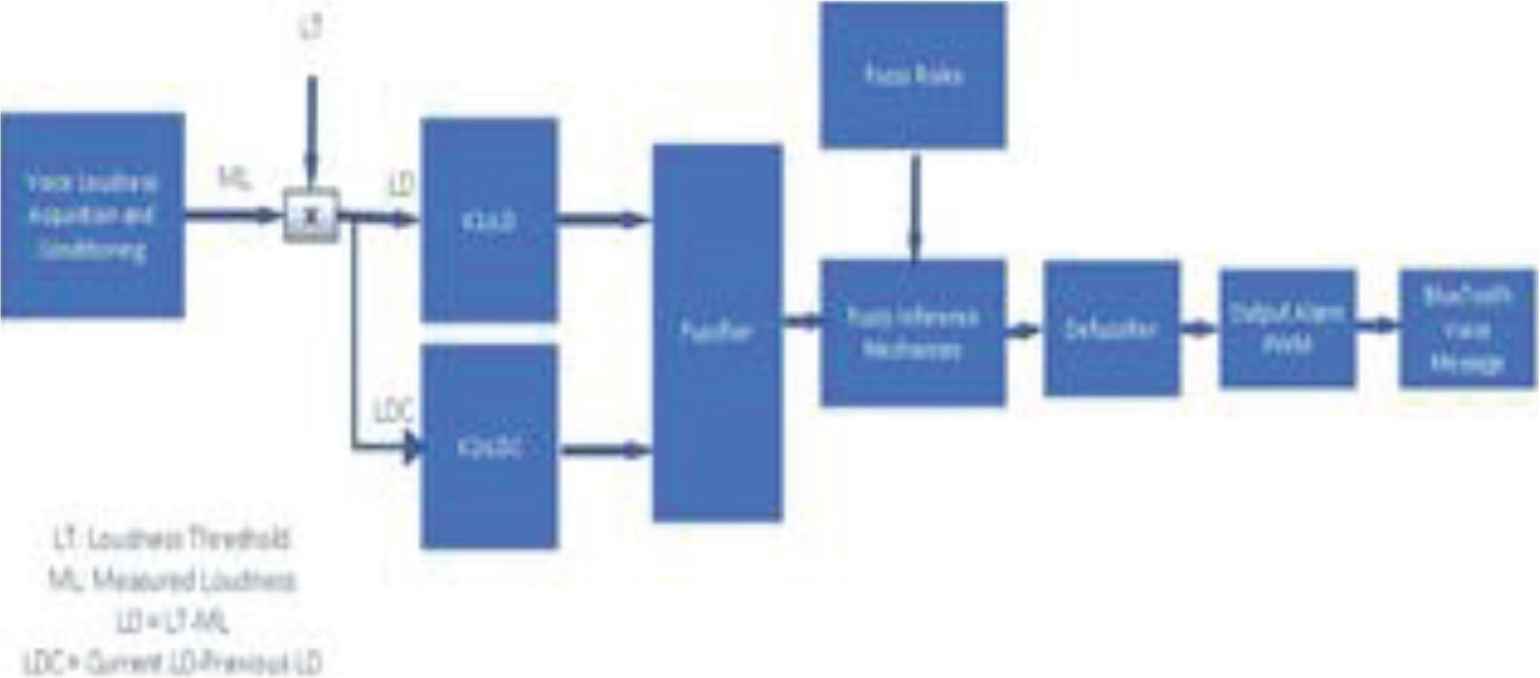
The loudness biofeedback fuzzy logic based monitoring system.
First, fuzzy-based system was designed using a graphical user interface with the fuzzy rules stored in the fuzzy system editor as shown in Figure 4.
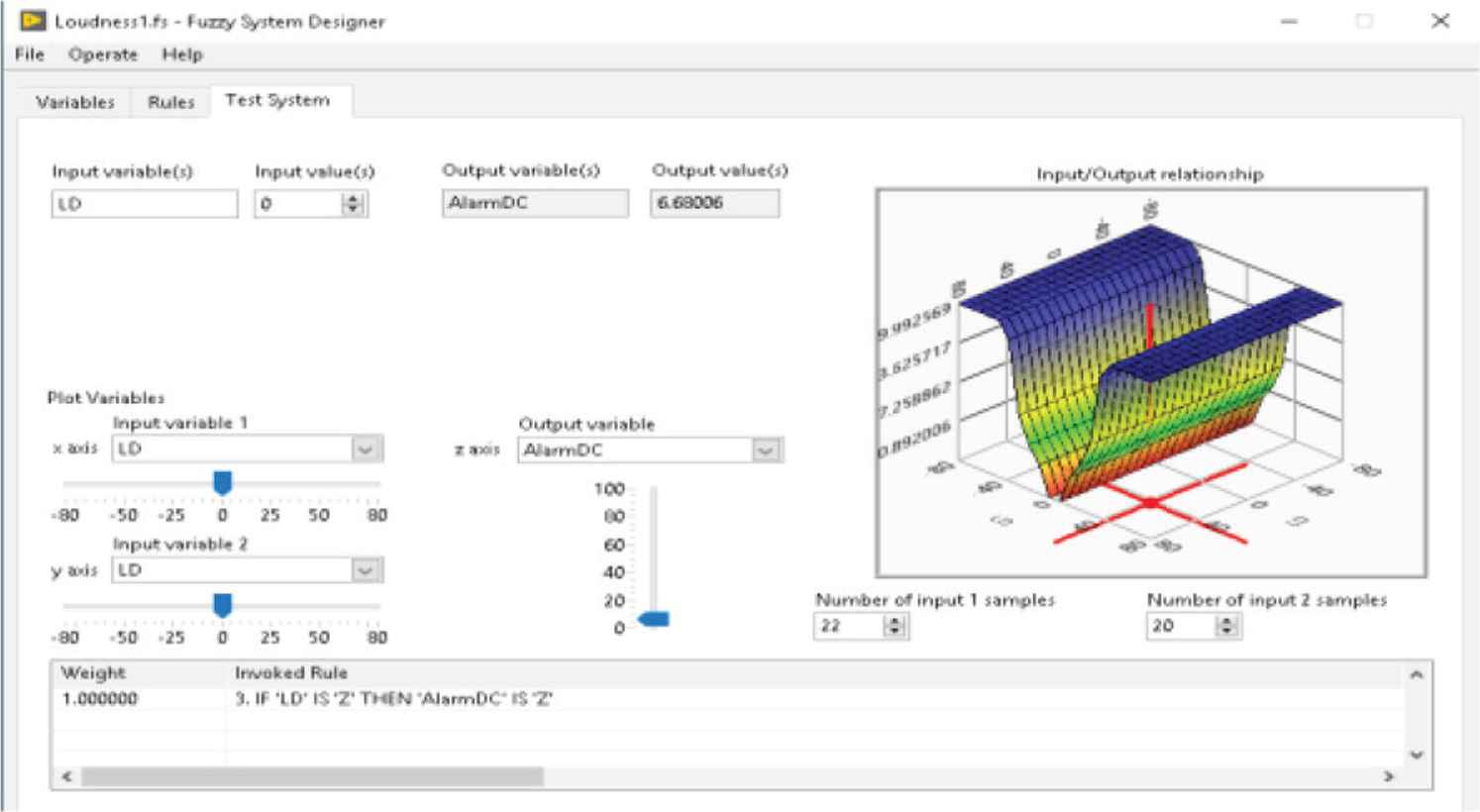
Fuzzy system editor.
The designed fuzzy logic system is a Multiple Input and Single Output system where the difference between the measured intensity (LD) and threshold intensity level and change of intensity to normal level (LDC). The output variable is alarm of up-normal cases calculated as duty cycle (AlarmDC).
Our objective is to check that intelligent system behaves better than conventional system to control the loudness level using fuzzy logic. The fuzzy system is designed with two input variables and one output variable. For the classical fuzzy logic system, the input variables are LD and LDC and the output variable is AlarmDC. Mamdani’s method is used to control loudness level by creating the linguistic rules which is considered easy to interpret by human operator. Triangular and trapezoid shaped membership functions are used for assigning the values to the input variables and the output variable. The universe of discourse of intensity difference, change of intensity and AlarmDC are (−80 to 80), (−100 to 100) and (0–100%), respectively.
The membership functions for LD and LDC inputs consist of Negative Large (NL), Negative Small (NS), zero (Z), Positive Large (PL) and Positive Small (PS) as shown in Figures 5 and 6.
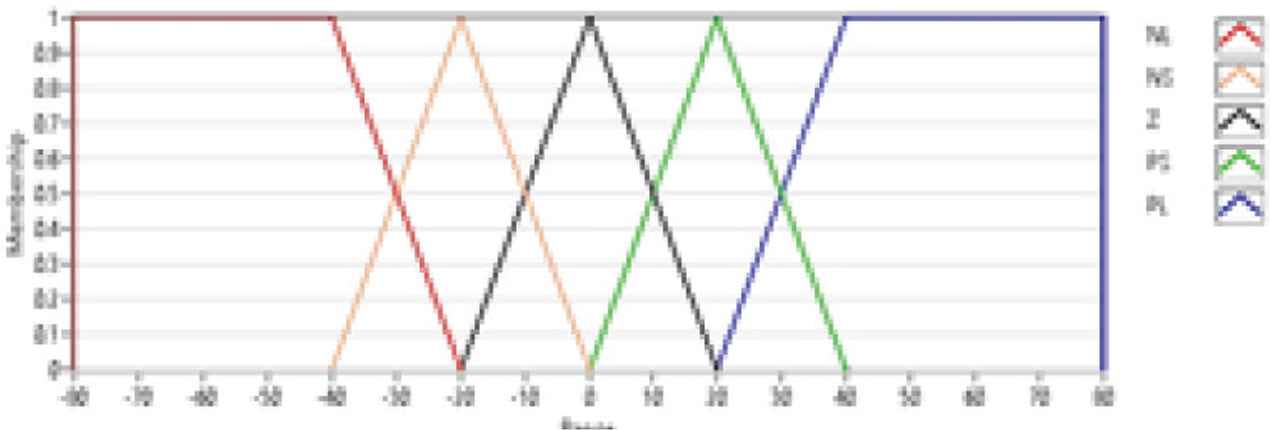
The membership functions for LD input.
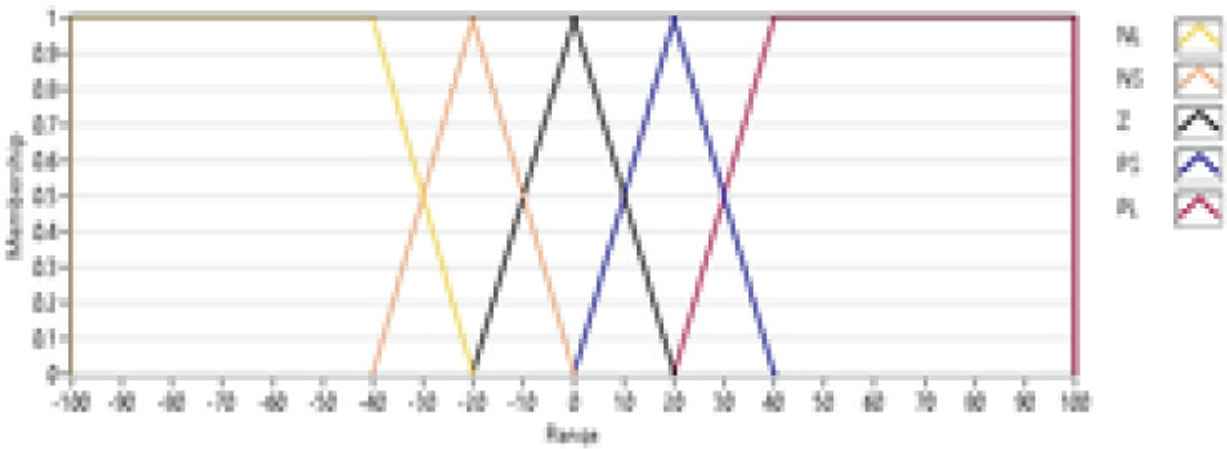
The membership functions for LDC input.
The output AlarmDC variable value was chosen in the range of 0–100% with variable frequency output based on percentage of high or low loudness. The membership functions for AlarmDC output as zero (Z), small (S), medium (M) and large (L) as shown in Figure 7.
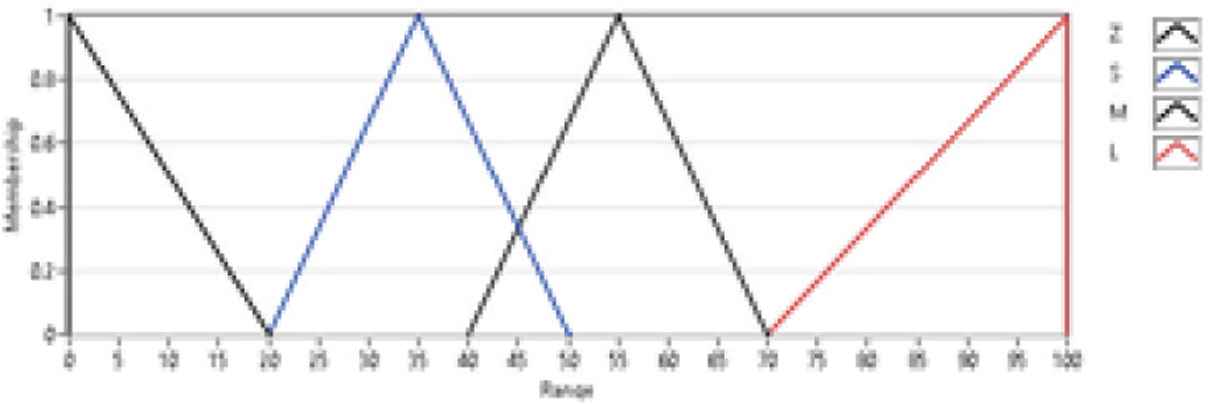
The membership functions for LDC input.
In the design of the fuzzy inference system was formulated which does the mapping from the given input to an output using fuzzy logic as shown in Figure 8. For evaluating the linguistic rules of the fuzzy logic Max–Min inference system has been used. In developed FLS, the centroid defuzzification method has been used.
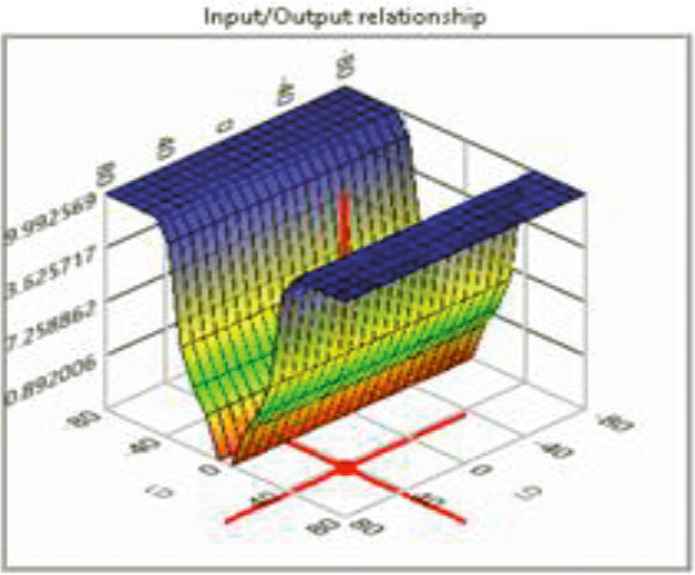
Input/Output relationship of FLS.
3. SIMULATION AND VALIDATION
A user interface Virtual Instrument (VI) is designed to simulate and validate FLS using graphical language as shown in Figure 9 which shows the front panel of VI in testing mode. In the simulation loop there exists one input node and one output node to configure parameters interactively to determine the alarm output level represented as duty cycle based on the loudness level.
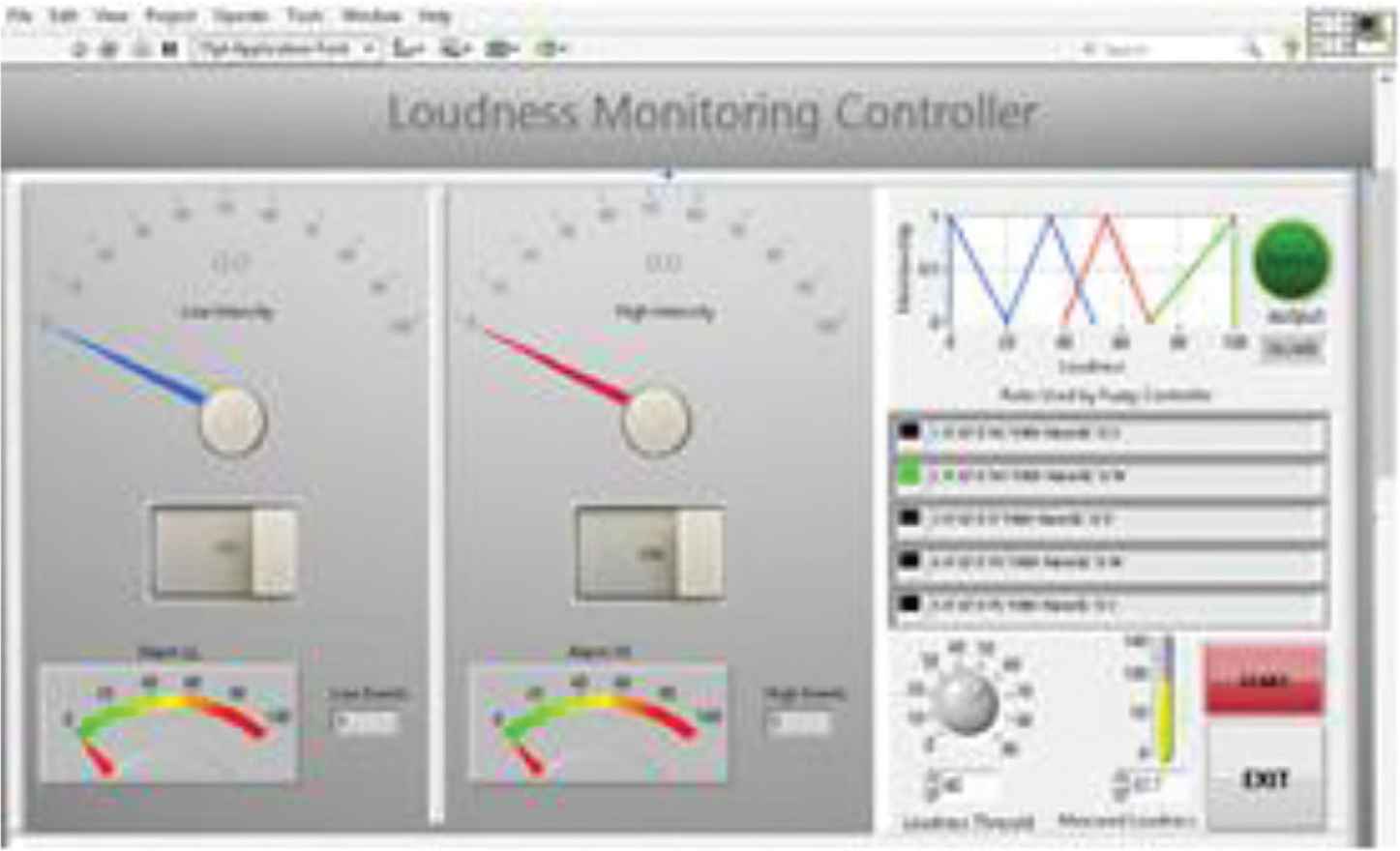
Front panel of the loudness monitoring controller.
A simulated voice level is used in the VI as an input and threshold level preset by a speech therapist and set prior to use, based on the patient’s requirements. These two inputs are used as inputs to fuzzy logic system. The softer or louder the patient speaks, the lower or higher the intensity measured by FLS. The FLS then utilizes the specified rules to process the input data and decides whether or not the led alarm and audio feedback should be sent to the patient in addition to the length of the feedback alarm based on the up normal level.
First, when the start button is pushed, the code will determine the threshold level above the background noise. This alarm threshold is the loudness level the patient needs to speak above or below.
Then, it will start processing using fuzzy logic rules. If the simulated voice signal level received is below or above the speaking threshold, the output audio alarm is activated with message instruction. During times in which the user is not speaking, the counter is held constant, while speaking below the threshold, the counter is tracking the number of both events low and high alarms in addition to the level of loudness. The test continues by taking another simulated input sample to define the new level and then determine whether to set the alarm or not. This loop repeats until the user stops the test and exits.
4. RESULTS ANALYSIS AND DISCUSSION
A complete simulation for evaluation was performed using the initial designed, simulated and developed and assembled using a breadboard to evaluate the connections to each unit of the system. Each stage of the intelligent system was implemented, tested and calibrated separately. The processing stage using the programmable microcontroller was simulated first using different levels of speech intensity of speech-like signals. Second, it was tested by different normal subjects who were asked to speak for few minutes using different levels of speech intensity and test to speak softly or loudly a few seconds and check if the biofeedback activates the audio alarm. To make accurate tests a sound level meter for voice monitoring was used to monitor the volume of voice loudness to adjust the biofeedback to be activated when low or excessive speech intensity. After calibrating the device, the device was tested for different levels of voice intensity which proves for the different tests that the system was successful.
5. CONCLUSION
The Intelligent Biofeedback Fuzzy Logic-based Device for Monitoring and Treatment of Voice Loudness developed as a prototype has achieved the objective of this work. The device achieved the proposed considerations regarding the accuracy, ease of programmability, patient alert, automatic tracking of up normal occasions during therapeutic sessions. The device features with its portability due to its small size, in addition to low power consumption. The developed intelligent voice monitoring system performed satisfactorily as a prototype system for monitoring, to provide a patient with information about voice loudness level accurately outside the clinic and for controlling of the treatment of upnormal vocal loudness levels without the need to the continuous therapeutic follow-up in speech pathology clinic. The device is able to collect voice loudness levels through a throat microphone and able to discriminate between voice and silence and is only active when the subject is speaking. The device activities an audio alarm as a biofeedback to the subject whenever the voice intensity level falls below or exceeds above adjustable single threshold for a preset time interval. The device has USD external memory to store information concerning time dependent data of the user’s voice intensity when alarms occurred in and counts of up normal events. These data can be displayed by a speech therapist to monitor the patient’s progress and make changes to the therapy program.
To test the device feasibility as a monitoring and therapeutic device for voice disorders, Clinical evaluations are required to be done.
CONFLICTS OF INTEREST
The author declares they have no conflicts of interest.
ACKNOWLEDGMENT
I would like to extend my appreciation to the Deanship of Scientific Research and the Research Center of College of Applied Medical Sciences at King Saud University for funding this research.
AUTHOR INTRODUCTION
Ali S. AlMejrad
 He received the B.Sc. with first honour in Electrical Engineering from King Saud University, Kingdom of Saudi Arabia, M.Sc. in Bioengineering from Strathclyde University, UK in 1987 and 1990, respectively; and the PhD in Medical engineering from University of Edinburgh, UK, in 1996. He is currently an Associate Professor of Medical Engineering and Instrumentation in Biomedical Technology in the College of Applied Medical Sciences, KSU, KSA. His research interests include Development of Biomedical Instrumentation and Intelligent Systems for Health Care using advanced Technologies. He is a member of IEEE and IPEM.
He received the B.Sc. with first honour in Electrical Engineering from King Saud University, Kingdom of Saudi Arabia, M.Sc. in Bioengineering from Strathclyde University, UK in 1987 and 1990, respectively; and the PhD in Medical engineering from University of Edinburgh, UK, in 1996. He is currently an Associate Professor of Medical Engineering and Instrumentation in Biomedical Technology in the College of Applied Medical Sciences, KSU, KSA. His research interests include Development of Biomedical Instrumentation and Intelligent Systems for Health Care using advanced Technologies. He is a member of IEEE and IPEM.
REFERENCES
Cite this article
TY - JOUR AU - Ali S. AlMejrad PY - 2020 DA - 2020/02/26 TI - Design and Development of Intelligent Wearable Biofeedback Fuzzy Logic-based Device for Monitoring and Treatment of Voice Loudness JO - Journal of Robotics, Networking and Artificial Life SP - 209 EP - 212 VL - 6 IS - 4 SN - 2352-6386 UR - https://doi.org/10.2991/jrnal.k.200221.004 DO - 10.2991/jrnal.k.200221.004 ID - AlMejrad2020 ER -
